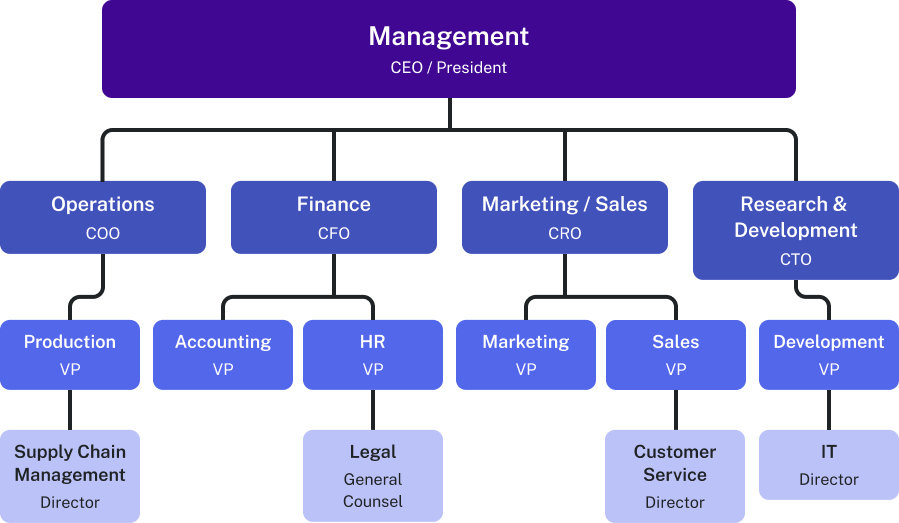Key People Within Functional Areas
Here is an example of the functional areas of a large technology manufacturing corporation and the key functions and people within.

The Management functional area in most large corporations is led by the Chief Executive Officer (CEO). Depending on company size, there may be a President in position as well.
The Operations functional area is managed by the Chief Operations Officer (COO). In this example, Operations consists of Production, led by a Vice President (VP), a Supply Chain department, and a Procurement area with Director-level people in charge.
The Finance functional area is led by the Chief Financial Officer (CFO), who is one of the most important “C-level” executives. In addition to running Finance and Accounting, the CFO is responsible for reporting company results to the financial community. Finance also contains Human Resources (HR) in many companies and the Legal department as well. It is common for the CFO to have VPs of HR, Accounting, and Legal as direct reports. HR contains functions like employee training, compensation and benefits, and recruiting. Accounting has multiple functions, such as Accounts Payable, Receivable, record-keeping, and cash flow. The Legal department is responsible for contracts, copyrights, and various negotiations on behalf of the company.
The Marketing/Sales functional area is managed by the Chief Revenue Officer (CRO), which is a relatively new addition to C-level executives. The CRO may have a Sales VP and Marketing VP as direct reports, but in some cases, the CRO may act as VP of Sales or Marketing. This functional area may also contain Customer Service (and Support) with a Director-level manager in charge. Marketing has specialized functions, such as communications (press releases), social media, data science analysis, and product marketing. Customer Service is usually responsible for Customer Relationship Management (CRM) and problem resolution and support.
Finally, the Research and Development functional area is the lifeblood of manufacturing businesses. R&D is staffed with scientists, thought leaders, subject matter experts, and industry analysts striving to provide the organization with knowledge and ideas to keep up with, and ahead of, the competition. R&D is led by the Chief Technology Officer (CTO), who manages a Development VP or similar title, depending on what technology products are being produced: semiconductors, athletic footwear, software systems, or dental appliances. In many organizations, the Information Technology area (IT), responsible for providing internal technology tools to the company’s employees, is housed in the R&D organization.